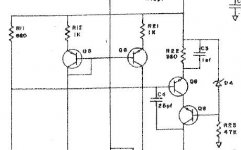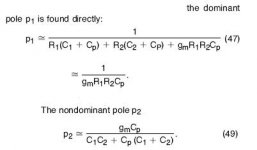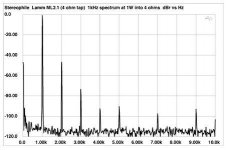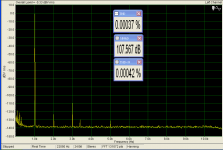Re: VAS fighting
APT1
Edmond Stuart said:edit: dumb question, what's that APT1 thingie? Does somebody have a link to the schematic?
APT1
VAS fighting
Thanks Brian.
Hmm... another example of heavily crippled VASes, hence no VAS fighting.
Thanks Brian.
Hmm... another example of heavily crippled VASes, hence no VAS fighting.
SY said:Isn't a loudspeaker a motor?
Maybe. I wonder if it is, more specifically, a "moving coil linear actuator"? Wasn't always so...
moving iron
 See also: wikipedia
See also: wikipediaHi Edmond,
Why APT VAS is defective? Did you mean 680 Ohm source instead of current mirrors?
Why APT VAS is defective? Did you mean 680 Ohm source instead of current mirrors?
From my dictionary: "motor- 4. a machine that converts electrical energy into mechanical energy."
Hi Dimitri,
I didn't mean defective, rather that the small resistors at the VAS input seriously reduce the gain, Miller effect and pole splitting.
BTW, I'm not the only one uses that C-word 😉 (i.e. Bob as well)
Cheers,
Edmond.
I didn't mean defective, rather that the small resistors at the VAS input seriously reduce the gain, Miller effect and pole splitting.
BTW, I'm not the only one uses that C-word 😉 (i.e. Bob as well)
Cheers,
Edmond.
Thanks,
- reduce the gain - do you mean overall gain on dc?
- reduce miller effect and pole splitting - I thought that the shift of the second pole on the frequency axis depends on the VAS transconductance...
- reduce the gain - do you mean overall gain on dc?
- reduce miller effect and pole splitting - I thought that the shift of the second pole on the frequency axis depends on the VAS transconductance...

pole splitting
Hi Dimitri,
In the first place I mean VAS gain, though this also affects the overall gain of course.
Err... you're right. I confused it with the lower output impedance* of an 'un-crippled' VAS, but this does not automatically mean more pole splitting.
edit: * at LF
Cheers,
Edmond.
dimitri said:Thanks,
- reduce the gain - do you mean overall gain on dc?
Hi Dimitri,
In the first place I mean VAS gain, though this also affects the overall gain of course.
- reduce miller effect and pole splitting - I thought that the shift of the second pole on the frequency axis depends on the VAS transconductance...
Err... you're right. I confused it with the lower output impedance* of an 'un-crippled' VAS, but this does not automatically mean more pole splitting.
edit: * at LF
Cheers,
Edmond.
Right. A motor where there is no net mechanical movement, except when you exceed SOA.SY said:From my dictionary: "motor- 4. a machine that converts electrical energy into mechanical energy."

John, I know you're big on the "minimize 7th harmonic deal"- we've certainly talked about that quite a bit and I can't disagree. In looking at some recent reviews of Stereophile Class A amps (I'm thoroughly unimpressed by their reviews and reviewers, but you do cite them quite often as validation of your work), I don't see much of a correlation between 7th harmonic and the reviewer ratings.
Re: VAS fighting
Edmond,
Just to make this clear. I think you are saying that the VAS current gain at low f is reduced and defined by the ratio of R11 to R22, as opposed to being left at the greater, but more variable beta of the miller Q (I can't make out the #, the one whose base connects to C4).
Edmond,
Just to make this clear. I think you are saying that the VAS current gain at low f is reduced and defined by the ratio of R11 to R22, as opposed to being left at the greater, but more variable beta of the miller Q (I can't make out the #, the one whose base connects to C4).
Attachments
Net, net. No dc movement. Unless your loudspeaker follows you around your house. Semantics, not important.SY said:I don't know about your speakers, but the voice coils on mine move.
Attachments
Right. I've struggled to find many spectral plots for loudspeakers. The couple I have seen are no strangers to 7th.SY said:...I don't see much of a correlation between 7th harmonic and the reviewer ratings.
Just out of curiosity, why do you suppose that Stereophile always shows spectral plots in its amplifier reviews but seldom if at all in its loudspeaker reviews (as far as I know)?
Brian
SY said:John, I know you're big on the "minimize 7th harmonic deal"- we've certainly talked about that quite a bit and I can't disagree. In looking at some recent reviews of Stereophile Class A amps (I'm thoroughly unimpressed by their reviews and reviewers, but you do cite them quite often as validation of your work), I don't see much of a correlation between 7th harmonic and the reviewer ratings.
Lamm @ 1W I could pick a dozen op-amps released in the last 5 yr. from anyone of three companies that would have no visible harmonics on this scale when used as a line stage driving a 50k pot.
Attachments
e.g this spectra - unloaded output ,simple class AB amp, unipolar input (single diferential, degenerated bipolar input stage) and unsymetrical VAS, complementary output, 30V RMS (divider30dB at output to match level for soundcard input).that would have no visible harmonics on this scale when used as a line stage driving a 50k pot
Attachments
BV said:
e.g this spectra - unloaded output ,simple class AB amp, unipolar input (single diferential, degenerated bipolar input stage) and unsymetrical VAS, complementary output, 30V RMS (divider30dB at output to match level for soundcard input).
That's about right -110dB is approximately the noise floor in the LAMM plot. I don't know what the input level is for 1W but it is probably much lower than 30V rms 🙂.
I don't want to presume to explain Edmond's point for him, but on the matter of that datasheet formula NS make a bunch of simplifications in order to keep the maths more manageable (see Fig. 20), one of which is to assume the beta is infinite. If one assumes the beta is infinite then one can pretend that it doesn't matter.dimitri said:where is beta? where is current gain?
- Status
- Not open for further replies.
- Home
- Amplifiers
- Solid State
- John Curl's Blowtorch preamplifier



